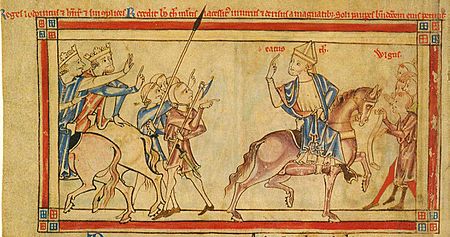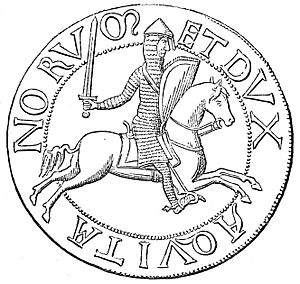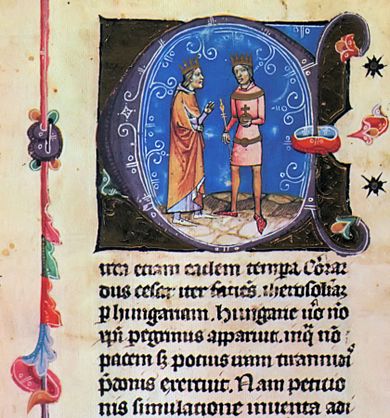Louis VII of France facts for kids
Quick facts for kids Louis VII |
|
|---|---|

Effigy of Louis VII on his seal
|
|
| King of the Franks (more...) | |
| Senior king | 1 August 1137 – 18 September 1180 |
| Coronation | 25 December 1137, Bourges |
| Junior king | 25 October 1131 – 1 August 1137 |
| Coronation | 25 October 1131, Reims Cathedral |
| Predecessor | Louis VI |
| Successor | Philip II |
| Born | 1120 |
| Died | 18 September 1180 (aged 59–60) Paris |
| Burial | Barbeau Abbey, then (1817) Saint-Denis Basilica |
| Spouse |
|
| Issue Detail... |
|
| House | Capet |
| Father | Louis VI of France |
| Mother | Adelaide of Maurienne |
Louis VII (born 1120 – died 18 September 1180) was a King of the Franks from 1137 to 1180. He was often called the Younger or the Young. Louis was the son of King Louis VI.
He married Eleanor of Aquitaine, who was one of the richest and most powerful women in Western Europe. This marriage temporarily made the Capetian lands much larger.
Louis went on the Second Crusade in 1147. During this journey, he visited the court of King Géza II of Hungary. While in the Holy Land, his marriage to Eleanor became difficult. He returned to France in 1149.
During Louis's time as king, the famous University of Paris was started. He and his advisor, Abbot Suger, worked to make the government stronger. They also supported the building of French Gothic architecture, like the famous Notre-Dame de Paris.
Louis's marriage to Eleanor was ended in 1152 because they did not have a son. Soon after, Eleanor married Henry Plantagenet. Henry became Duke of Normandy and Count of Anjou. Eleanor gave him her lands in Aquitaine. This created a huge new kingdom called the Angevin Empire.
Louis later supported Henry's rebellious sons to cause trouble in the Angevin lands. Louis then married his second cousin, Constance of Castile, but still had no son. Constance died giving birth to their second daughter. Five weeks later, he married Adela of Champagne. Finally, they had a son named Philip. Louis died in 1180, and his son Philip II became the next king.
Contents
Early Life and Becoming King
Louis was born in 1120. He was the second son of Louis VI of France and Adelaide of Maurienne. At first, Louis was expected to have a career in the church. He became very educated and religious.
But his life changed when his older brother, Philip, died by accident in 1131. Suddenly, Louis became the next in line for the throne of France. In October 1131, his father had him officially made king by Pope Innocent II at Reims Cathedral.
Louis spent much of his youth at Saint-Denis. There, he became good friends with Abbot Suger. Suger was an advisor to Louis's father and also helped Louis when he first became king.
First Years as King
After Duke William X of Aquitaine died, King Louis VI quickly arranged for his son to marry Eleanor of Aquitaine. They married on July 25, 1137. Eleanor had inherited all of William's lands. Louis VI wanted to add the huge region of Aquitaine to his family's French lands.
On August 1, 1137, shortly after the wedding, Louis VI died. Louis VII then became king. The marriage between the religious Louis and the lively Eleanor was difficult. Eleanor reportedly said she thought she was marrying a king, but found she had married a monk.
Their cultures were very different. Louis grew up in the serious northern court of Île-de-France. Eleanor was used to the rich, free-spirited court life of Aquitaine. Louis and Eleanor had two daughters: Marie and Alix.
At the start of his reign, Louis VII was very active and determined. His rule began with some unrest. Townspeople in Orléans and Poitiers wanted to form their own self-governing groups.
Louis soon had a big disagreement with Pope Innocent II. This happened when the position of archbishop in Bourges became empty. The king supported his own candidate, Cadurc. But the Pope wanted Pierre de la Chatre for the job. Louis swore that Pierre would never enter Bourges while he was alive. Because of this, the Pope put a ban on the king, meaning church services could not be held in his lands.
Louis VII then got into a war with Theobald II of Champagne. Louis allowed Raoul I of Vermandois, a high-ranking official, to divorce his wife. She was Theobald II's sister. Raoul then married Petronilla of Aquitaine, who was Queen Eleanor's sister.
Because of this, Champagne sided with the Pope in the Bourges dispute. The war lasted two years (1142–44). The royal army took over Champagne. Louis VII was personally involved in attacking and burning the town of Vitry-en-Perthois. About 1,500 people who had hidden in a church died in the fire.
The church leaders strongly criticized Louis. He removed his armies from Champagne and gave the lands back to Theobald. He accepted Pierre de la Chatre as archbishop of Bourges. To make up for his actions, Louis announced he would go on a crusade. This was on Christmas Day 1145. Bernard of Clairvaux helped make the crusade popular by preaching about it in 1146.
Meanwhile, Geoffrey V, Count of Anjou, finished taking over Normandy in 1144. Louis recognized Geoffrey as Duke of Normandy. In return, Geoffrey gave Louis half of the county of Vexin. This area was very important for Normandy's safety. At the time, Louis thought this was a smart move. But it later helped the Angevin family gain more power.
In June 1147, Louis VII and Queen Eleanor began their journey for the Second Crusade. They started from the Basilica of Saint-Denis. They traveled overland to Syria. They stopped in the Kingdom of Hungary, where King Géza II of Hungary welcomed them. Géza II asked Louis VII to be the godfather for his son Stephen.
Years later, Louis's daughter Margaret married Géza's son Béla III of Hungary. After getting supplies from Géza, the armies continued their march. Near Laodicea, the French army was attacked by Turks. In the battle of Mount Cadmus, the Turks first shot arrows and threw stones. Then they attacked from the mountains and killed many French soldiers.
Louis VII and his army finally reached the Holy Land in 1148. Queen Eleanor wanted to help her uncle, Raymond of Poitiers, in Antioch. She urged Louis to help Antioch against Aleppo. But Louis VII wanted to fulfill his promise to visit Jerusalem. He secretly left Antioch. He joined King Conrad III of Germany and King Baldwin III of Jerusalem. They tried to lay siege to Damascus, but it failed. Louis VII decided to leave the Holy Land, even though Eleanor protested. Louis VII and the French army returned home in 1149.
Changes in Power
The trip to the Holy Land cost a lot of money and weakened the army. It also caused a big problem between Louis and Eleanor. This led to their marriage being ended. Perhaps the marriage might have continued if they had a son. But they only had daughters.
The Council of Beaugency found a reason to end the marriage. They said Louis VII and Eleanor were too closely related for their marriage to be legal. So, the marriage was ended on March 21, 1152. The real reason was the hostility between them and the low chance of having a son.
On May 18, 1152, Eleanor married the Count of Anjou, who would become King Henry II of England. She gave him the duchy of Aquitaine. They had three daughters and five sons. Louis VII started a war against Henry for marrying without his permission. But Louis's enemies were defeated. Their lands were damaged, and their property was stolen. Louis became ill with a fever and returned to France.
In 1154, Louis VII married Constance of Castile. She was the daughter of King Alfonso VII of Castile. She also did not give him a son. She had two daughters: Margaret and Alys. By 1157, Henry II of England thought Louis might never have a son. This would make the future of France uncertain.
Henry wanted to secure a claim for his family. He sent his chancellor, Thomas Becket, to arrange a marriage. It was between Margaret and Henry's son, Henry the Young King. Louis agreed to this. By the Treaty of Gisors (1158), he promised the young couple would marry. As a wedding gift, he gave them the city of Gisors and the area around it.
Louis VII was very sad when Constance died during childbirth on October 4, 1160. He was desperate for a son. So, he married Adela of Champagne just five weeks later. To balance this, Henry II quickly had his son Henry "the Young King" marry Margaret.
Louis understood the danger of Henry II's growing power. But he was often unsure and did not have as many resources as Henry II. So, he could not effectively stop Henry's influence. One of his few successes was a trip to Toulouse in 1159. He went to help Raymond V, Count of Toulouse, who Henry II had attacked. Louis entered the city with a small group, saying he was visiting his sister. Henry said he could not attack the city while his lord was inside, and went home.
Diplomacy and Later Years
During Louis's reign, Holy Roman Emperor Frederick I tried to claim lands in southeastern France. A split in the church leadership, called a papal schism, happened in 1159. Louis VII supported Pope Alexander III, who was Frederick I's enemy.
After two failed attempts for Frederick I to meet Louis VII, Louis fully supported Alexander III. The Pope lived in Sens from 1163 to 1165. In return for Louis's loyalty, the Pope gave him the Golden Rose.

More importantly for English history, Louis supported Thomas Becket, the Archbishop of Canterbury. Louis tried to help Becket and Henry II make peace. Louis sided with Becket to cause problems for Henry. But even Louis became annoyed with Becket's stubbornness. He once asked Becket, "Do you wish to be more than a Saint?"
Louis also tried to weaken Henry by supporting Henry's rebellious sons. He encouraged trouble within the Plantagenet family. He made Henry's sons, not Henry himself, the feudal lords of the French lands. But the sons' rivalry and Louis's own indecision broke up their alliance (1173–1174). Finally, in 1177, the Pope stepped in to make the two kings agree to terms.
In 1165, Louis's third wife had a son and heir, Philip. Louis had him crowned at Reims in 1179. This was a tradition for the Capetian kings. Philip would be the last king crowned in this way. Louis himself could not be there because he was suffering from paralysis. He died on September 18, 1180, in Paris. He was buried the next day at Barbeau Abbey, which he had founded. His remains were moved to the Basilica of Saint-Denis in 1817.
Marriages and Children
Louis had children from his three marriages:
With Eleanor of Aquitaine:
- Marie (1145 – 11 March 1198), who married Henry I of Champagne.
- Alix (1151–1197/1198), who married Theobald V of Blois.
With Constance of Castile:
- Margaret (1158 – August/September 1197), who married (1) Henry the Young King; (2) King Béla III of Hungary.
- Alys (4 October 1160 – about 1220), who was engaged to Richard I of England; she married William IV, Count of Ponthieu.
With Adela of Champagne:
- Philip II Augustus (22 August 1165 – 1223).
- Agnes (1171 – after 1204), who married 1) Alexius II Comnenus (1180–1183), 2) Andronicus I Comnenus (1183–1185), then 3) Theodore Branas (1204).
Fictional Portrayals
Louis is a character in Jean Anouilh's 1959 play Becket. In the 1964 film adaptation, he was played by John Gielgud. Gielgud was nominated for an Academy Award for Best Supporting Actor.
Louis was also played by Charles Kay in the 1978 BBC TV drama series The Devil's Crown. He has a role in Sharon Kay Penman's novels When Christ and His Saints Slept and Devil's Brood. The early part of Norah Lofts' book about Eleanor of Aquitaine talks a lot about Louis VII. It shows his relationship with Eleanor from her point of view. Louis is also a main character in Elizabeth Chadwick's novel The Summer Queen.
|
Louis VII of France
Born: 1120 Died: 18 September 1180 |
||
| Regnal titles | ||
|---|---|---|
| Preceded by Louis VI |
King of France 1131–1180 with Louis VI (1131–1137) Philip II (1179–1180) |
Succeeded by Philip II |
| French nobility | ||
| Preceded by Eleanor as sole ruler |
Duke of Aquitaine 1137–1152 with Eleanor |
Succeeded by Eleanor as sole ruler |
See also
 In Spanish: Luis VII de Francia para niños
In Spanish: Luis VII de Francia para niños





